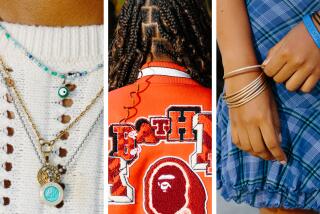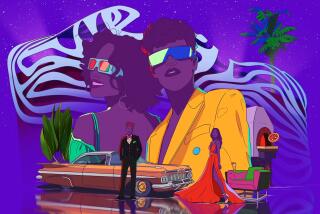It’s Me, Me, Me as School Spirit Slips Off the Ring
A battle for the hearts, minds and fingers of the nation’s high school students is being waged in the tiniest of theaters: the side panels of senior class rings.
School mascots and graduation year, the hallmarks of rings in the past, are being bumped aside or minimized to make room for “pride sides” -- minuscule designs that would be hard to link to in-class accomplishment, including zodiac and peace signs, skateboarders, ethnic flags, rock climbers and figure skaters.
And there are thousands more options, an explosion of choice that is part of the industry’s efforts to revive interest in a tradition that may have peaked with poodle skirts.
Companies are turning to high-tech sales tools, lower-priced mystery metals and overall fashion trends to compete against the unending similarly priced choices teens have to reward themselves for completing high school. (“Do I want a mini-iPod or a ring that is dangerously close to something my parents wore?”)
Although ring companies still employ campus representatives, they have begun pointing students toward the Internet, where “configurators” enable would-be buyers to design rings and view the results before committing. Product developers attend jewelry and accessory trade shows to plug into the latest fads, then incorporate them into designs that often end up looking more like promise rings than military-style salutes to specific schools. (The school ring tradition began at the U.S. Military Academy at West Point in 1835.)
“I joke that our slogan should be, ‘Bling-bling, buy a class ring,’ ” says Deb Gabor, director of retail marketing for ArtCarved, which sells school rings in jewelry stores.
When you throw in the hundreds of ring options -- from color, cut and adornment of the stone to type of metal and style of ring -- it can make flipping through a half-pound ring catalog about as much fun as cramming for the SAT. And although price remains an issue for some students, relevance may be a bigger one, educators and people in the industry say, as being true to one’s school increasingly takes a back seat to being true to oneself.
“We are kind of losing touch with the idea of a ring bringing a class together as a unit. With the ring evolving into me-me-me product design, the school is less and less a part of the process,” says Kean Chan, product manager for Balfour, based in Austin, Texas, one of the big three companies that sell rings on campuses.
A few schools, especially more traditional private ones, are moving back to the one-ring concept that they see as more unifying, Chan and others say.
Ring companies are also dealing with a backlash over too much choice by streamlining catalogs and pricing structures that can seem as complicated as calculus.
The equation was simpler before the one-design-fits-all approach began losing ground in the mid-1970s, when the first “activity panels” and fashion rings that bore little resemblance to their traditional counterparts were introduced by ArtCarved, which is owned by the same company as Balfour.
“Those designs led to one-upmanship, and it kind of got out of hand,” Chan says. “Once the genie is out of the bottle, you can’t put it back in. Who doesn’t want choice?”
When Jenny Silver, a sophomore at Oak Park High in Ventura County, ordered her $360 white-gold ring this spring from Herff-Jones, another major on-campus retailer, her first instinct was to place a ballet or dance icon on one side. But she had a change of heart.
“I put a Jewish star on the side, because I am always going to be Jewish,” the 16-year-old says. “I am not always going to be dancing.”
‘A Series of Choices’
About half the nation’s students purchase a class ring, according to industry estimates. That’s down about 15% from a decade ago, says Chan. Given prom bids, grad night, senior portraits and graduation announcements, “the price of being a senior is astronomical,” says Jon Lyons, the student body advisor at Pasadena High School. “Some do say, ‘I’d rather have a ring than go to the prom.’ It’s a series of choices students and parents have to make.”
With the average cost of a ring about $250 to $275, one of the first expenses to go may be a piece of jewelry whose post-graduation destiny is the sock drawer. Or, in Lyons’ case, a closet where he thinks he may have stashed his 1991 ring from San Bernardino High.
Society has changed since the grandparents of today’s high school students exchanged school rings to go steady, families stayed put and a gold ring cost less than $50. “I don’t know if kids have that 1950s attachment to school that they used to. We have a lot of kids moving in and out of the school. There’s just not that fascination with rings anymore,” says Lyons. “Besides, $200 is a car payment for these kids.”
He estimates fewer than half of Pasadena High’s students order rings, and the subject often doesn’t even come up until the end of their senior year.
“I don’t wear jewelry, so I didn’t want a class ring,” says Chris Howard, 18, a senior at Pasadena High. “But my mom said, ‘Just get it for the memories.’ ”
Like many of his fellow Pasadena High students who are trying to hold down costs, Howard went to Daniel’s, a local chain that carries the ArtCarved brand, and ordered a close copy of a ring sold on campus by Jostens, a top manufacturer based in Minneapolis.
The same trend is evident at Garfield High in East Los Angeles, where ring sales have decreased over the last two years, says Pat Calderon, an assistant financial manager at the school.
When students buy rings, educators say, they often try to save money by choosing a less costly nonprecious metal while still going all out to personalize it.
Jostens introduced its first low-cost alternative to gold, a mix of silver and gold called Duratone, during the Depression.
Across the industry, today’s less pricey substitute is the Spam of high school rings, an alchemy of nonprecious metals often labeled “jewelry-quality stainless steel” that can still run about $200. The same ring in 10-karat gold might cost 50% more
These proprietary formulas that bear names worthy of a counterfeit periodic table -- Lustrium, Siladium, Ultrium -- were invented when the price of gold soared in the 1970s.
So far this year, 60% of the rings Balfour sells are made of Siladium. As recently as five years ago, 75% of the rings Balfour sold were gold.
‘Personalized Society’
The demand for personalization can also be traced to the outburst of campus activities over the last 50 years, according to Jostens.
It’s not unusual for a school to offer 20 sports, plus band, choir, drama and other groups, says Tim Larson, vice president of marketing for the company that sold its first class ring in 1921.
“We live in a customized and personalized society. All you have to do is listen to all of the cellphone rings. Everyone wants to have some uniqueness and be a part of the group,” says Rich Stoebe, director of marketing for Jostens.
By seeing rings as an opportunity for self-expression, students are redefining the concept of a class ring, manufacturers say. Requests for symbols of faith, from a cross to a specific psalm, are increasing. Many appear on rings for home-schooled children, with “Deus Veritas Familia” (God, truth, family) or “Home Education” circling the stone where the high school name would be. Since introducing a home school line in 2000, sales have increased 25% at ArtCarved.
Sports that usually don’t offer the prospect of a varsity letter -- from kayaking and windsurfing to martial arts and motocross -- have also become insignias. Jostens, which is licensed to offer pro football and hockey logos, says the Oakland Raiders and Mighty Ducks are the most popular in their respective categories.
To capitalize on what Gabor calls the “super-hot” personalization trend reflected in Tiffany initial necklaces and personalized handbags, ArtCarved came up with a line last year that practically turns a student’s super-specific experience into a mini-tribute.
“You can take the personalization all the way down to the position you played and the jersey number you wore in a sport,” says Gabor. “You weren’t just in the band, you were first chair. You weren’t just a cheerleader, you were captain.”
The “bling-bling factor” is also manifesting itself in diamonds or cubic zirconias that pop up as the zeroes in the class year, she says. Jostens has a new line that allows students to incorporate stones in their names or their school mascot’s.
But being on the cutting edge of fashion can be such a relative term.
While at a ring event at a Minnesota school last year, a high school junior told Stoebe, “Well this year, I finally have the opportunity to put things on my ring that represent me -- NASCAR and fishing.”
*
(BEGIN TEXT OF INFOBOX)
Popular Icons
Jostens maintains a database of more than 5,000 “design-a-sides,” the ring maker’s term for the icons that can be carved on the side of a class ring. Here are 10 that Jostens says are popular with the current class:
Skateboarding
Environment
World peace
Rodeo
Fishing
Rock climbing
Surfing
Accounting
Journalism or yearbook
Country, hip-hop or rock music
And 10 more pulled from catalogs:
Awareness ribbons (eight colors)
Blessed Mother
Bowling
The Rev. Martin Luther King Jr.
Flag football
GED
Hunting
Lowrider
WWJD (What would Jesus do)
Yin and yang
Source:
Los Angeles Times
*
One size no longer fits all
In an effort to revive interest in class rings, jewelry manufacturers are offering more customization options to today’s high school students.
The first step is choosing a ring style and metal. “Jewelry- quality stainless steel” is a popular cost-saving selection.
Choose from birthstones, hematite, black onyx or mother of pearl. Diamonds or cubic zirconia can be accents.
Ring makers offer thousands of “pride side” icons ranging from sports or academic interests to awareness ribbons.
Rather not wade through a catalog? Manufacturers allow you to build your ring online and preview the results.
Images courtesy of ArtCarved
Los Angeles Times







